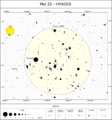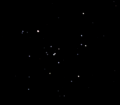Hyades cluster facts for kids
The Hyades (also known as Melotte 25 or Collinder 50) is a famous group of stars. It is the closest star cluster to our Solar System and one of the most studied star groups in the sky.
Imagine a family of stars! The Hyades cluster is made up of hundreds of stars that were all born around the same time and in the same place. They share similar chemical makeup and move together through space.
From Earth, the Hyades cluster looks like a "V" shape in the constellation of Taurus, which is often called "the Bull." You might notice a very bright star nearby called Aldebaran. Even though Aldebaran looks like it's part of the "V" shape, it's actually much closer to Earth and not truly part of the Hyades cluster. It just happens to be in the same direction from our view.
Scientists have measured the distance to the Hyades using different methods, including special telescopes like the Hubble Space Telescope. They agree that the center of the cluster is about 153 light-years away from us. That's a huge distance!
Bright Stars of the Hyades
The four brightest stars in the Hyades cluster are all red giants. These stars started their lives as hotter, bluer stars (called A-type stars) but have now grown much larger and cooler, turning red. They are all very close to each other in space.
These bright stars have special names:
- Gamma Tauri
- Delta Tauri
- Epsilon Tauri
- Theta Tauri
Together, they form the pattern that people imagined as the head of Taurus the Bull. One of these stars, Epsilon Tauri (also known as Ain, or "the Bull's Eye"), even has at least one gas giant planet orbiting it!
Age and Size of the Cluster
The Hyades cluster is quite old, about 625 million years old. The very center of the cluster, where the stars are packed most closely, is about 17.6 light-years across.
The entire cluster, including its outer parts, stretches much wider, about 65 light-years across. Scientists have found that about one-third of the stars confirmed to be part of the Hyades are actually outside this main boundary, in a kind of "halo" around the cluster. These stars are slowly drifting away from the cluster's main gravitational pull.
Images for kids
See also
 In Spanish: Híades (astronomía) para niños
In Spanish: Híades (astronomía) para niños





